Preparation of the overview section of the business plan
After the main part of the work on the business plan is completed and all sections of the document are ready, the developers begin to design it and prepare to convince stakeholders to participate in the project. However, the presentation participants may not pay attention to the project, if only because their first task is to select the most attractive ones on a competitive basis. This means that interest in in-depth reading of the document still needs to be aroused. The planner is assisted in this by the summary of the business plan, the part that provides a brief overview of it.
Prepare for persuasive influence
A business plan is a very pragmatically targeted document. The external tasks of its development prevail over the internal ones. For medium and small enterprises, business planning rarely goes beyond the format of cases and is drawn up into serious multi-page documents. The composition of the parameters for the management to decide on the launch of the project, as a rule, is simplified, and this is justified. The situation is different with external tasks or in a situation of a large diversified business. The main purpose of a business plan in such cases is to convince potential investors, bank executives or company owners on a number of points.
- The company has an experienced team capable of solving complex design problems.
- Natural doubts should be dispelled: the idea is valuable, and the product is in demand by the market.
- Evaluation of the effectiveness of the project indicates that the specified rate of return is achievable.
- The figures are not taken "from the ceiling", a serious study has been carried out.
- For each constructive question, a reasonable answer is provided.
- Risks have been assessed, measures to reduce them are effective.
- Scenario modeling provides the possibility of variability in the development of events.
- The company has a good backlog in project technologies, material and own financial resources.
The points mentioned above are the arguments for the thesis “consider a partnership with a project developer for investments, a loan” or “make a decision to include the project in the company's investment portfolio”. The main persuasive load is taken by the first, third and eighth points. The purpose of a business plan summary is substantially narrower than that of the entire document. It is intended to form the initial impetus for separate attention to the project in a series of presentations.
And even if a single project is being considered, the workload of executives of the rank of a strategic investor, a businessman with funds for investments, or a banker will not allow them to initially devote more than five to seven minutes. Then, if they consider it, then the actual text of the business plan will be transferred to the relevant services, and they will systematically work out every aspect of it. The first step is to make a positive first impression.
Preparation for persuading the participants of the presentation is built on the basis of consistently prepared:
- overview section (summary);
- fully formed document;
- persuasion plan;
- PowerPoint presentations.
Each of the designated points represents a certain technology and art at the same time. Since the author of the plan will not have a second chance to make a first impression, the summary plays a key role in this process. Below is a typical model for creating persuasion vectors and persuasiveness fields based on technology, which we will consider in a separate article. I will only briefly note that at a certain stage the author himself becomes congruent to the project (II), then he must rehearse the persuasion in front of the proposed object (III) and only then enter into a persuasive interaction with it (IV).
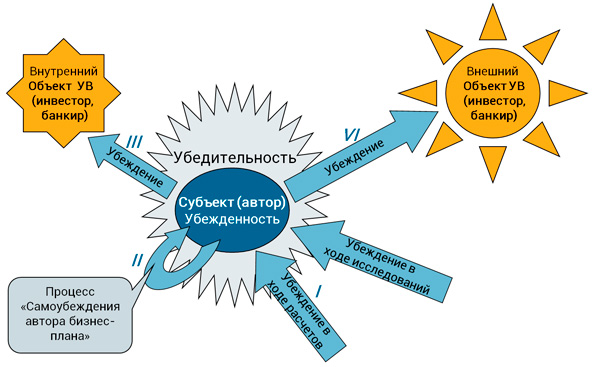
Scheme of vectors of persuasion, persuasion and field of persuasiveness in relation to the business plan
Resume structure
While the purpose of preparing a business plan summary is essentially promotional, it should never look like a flyer. He traditionally has a business style of writing. General phrases that have an emotional, major color should be excluded from the text of the section. Examples of such phrases might be:
- “we have unique opportunities”;
- “Investments will allow you to quickly increase sales volume”;
- “this solution is the best of its kind”, etc.
The laconic, dry language of the summary gives the reader a sense of objectivity and balance of the information received. At the same time, emotionally toned, embellished expressions, jargon give the impression of imposing a subjective position. The tone of writing this section, and indeed the entire document, should be emotionally even, and the information condensed for review should form an objective, unbiased picture of the plan.
It is desirable to fit the total volume of the review section into three A4 pages. In my opinion, the list presentation of the resume is the most successful, where each element is presented in conjunction: position - transcript. The exception is a short essay on the topic of the main idea of the project with a volume of 8-10 sentences. Below is an example of such a story. In general, the section usually consists of three conditional parts.
- Introductory part: the idea of the project and its goals.
- An abstract review of the elements of the business plan, including a description of the company and its type of activity, demand forecasting, investment and organizational needs, the main points of the financial plan and project performance evaluation. Sometimes the 1st and 2nd parts are interchanged with each other, which does not change the essence of the matter.
- A conclusion that captures the risk and success factors of the project, leading to a forecast of return on investment, return and premium.
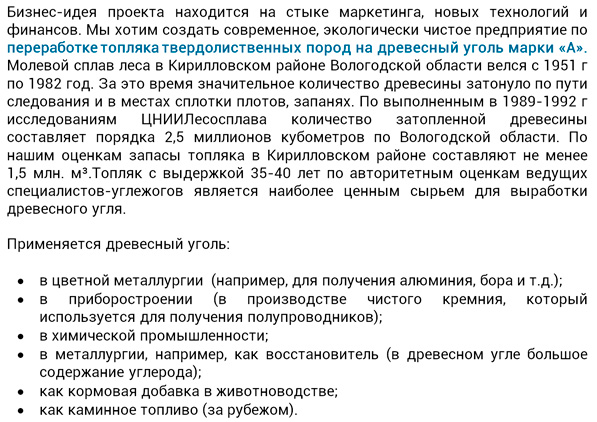
An example of a description of the main idea of the project
The most difficult thing in a resume is to present the main idea of the project and its goal in a business-like manner, but in an accessible way. This work is usually given the main attention. It is advisable to involve external experts to evaluate this part of the business plan review. It is usually judged whether the idea itself is attractive or not. In general, the general composition of the summarizing part usually consists of ten elements.
- Description of the main idea and purpose of the project.
- Brief information about the company.
- Product feature.
- Description of the possibilities of production and the experience of the company.
- Characteristics of the team and personnel for the purposes of the project.
- The results of the assessment of the market and the competitive environment.
- Parameters of the financial plan and evaluation of the effectiveness of the project.
- Project values for stakeholders, including the object of persuasion.
- Needs for financial resources, their sources and investment plan.
- Risks, ways to manage them, conclusion.
Almost every element of the resume has a direct link to the corresponding section of the main part of the business plan. For some moments, a separate decision of the management of the design company is required (for example, the name of the enterprise for the new business, its legal address, etc.). The following is an example of the content of a summary with an explanation of the sources for presenting information.
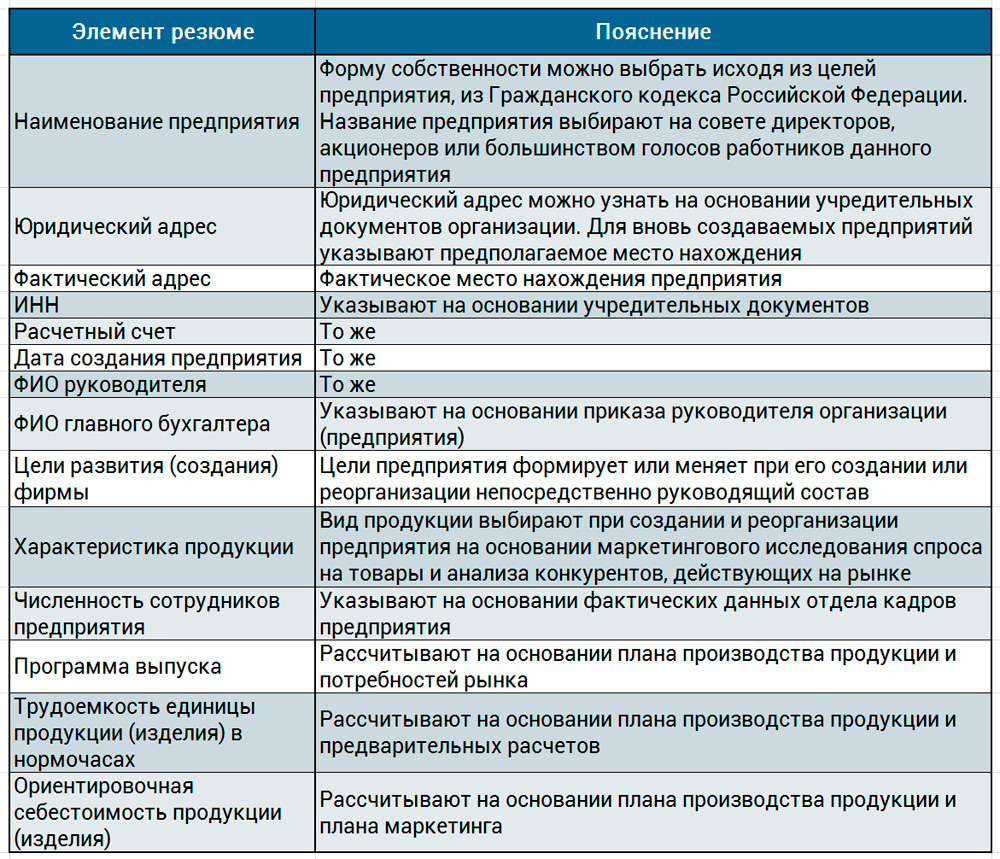
(click to enlarge)
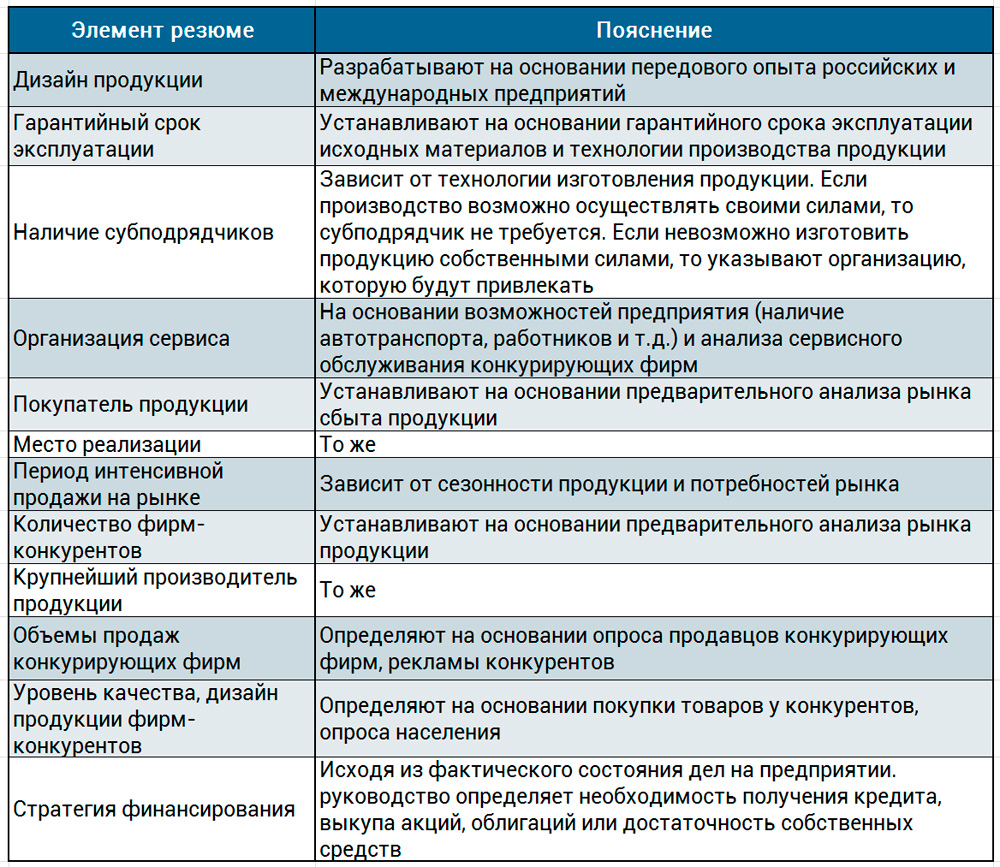
(click to enlarge)
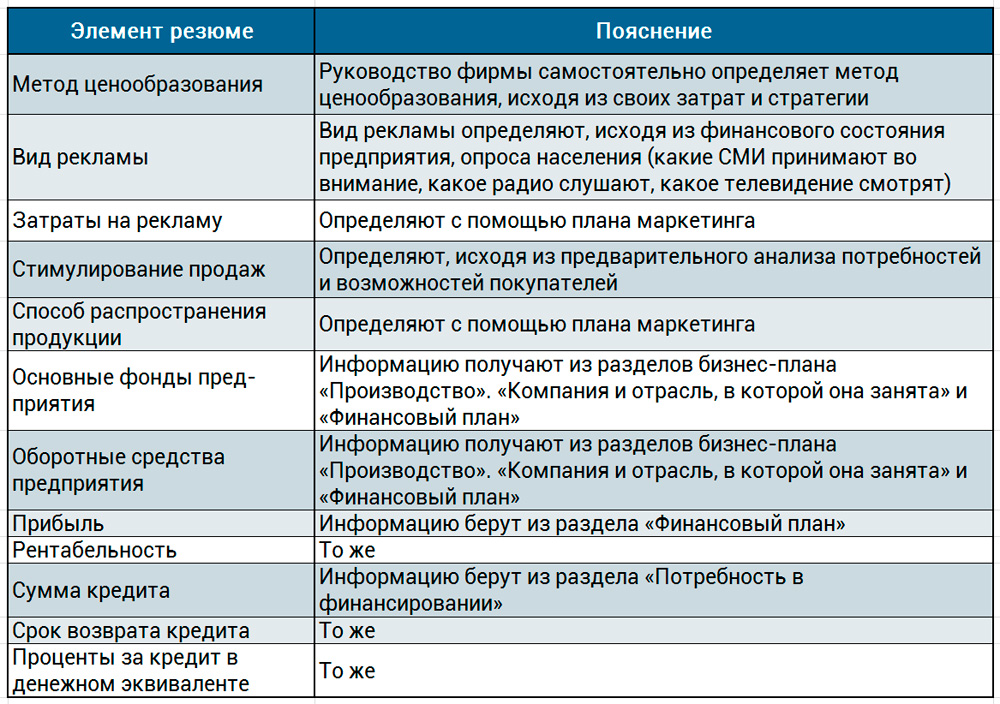
(click to enlarge)
Resume quality check
The success of persuading a potential investor, lender or your CEO depends to a high degree on how well the review is done. Therefore, even before preparing a presentation, it is necessary to repeatedly check its quality. Working on a business plan is a very time-consuming process. Moreover, it is iterative, it is performed with numerous return loops from the next section to the previous one and back. These actions often exhaust the authors so much that it is quite natural that the view of the document is “blurred”.
In this situation, the way out is quite simple. First, after the document is drafted and the first version of the resume is prepared, you need to give yourself the opportunity to take a break from it, switching to other work for a day or two. Secondly, while you are relaxing, get your colleagues involved and challenge them with a simple task: proofread the business plan and identify comments on spelling, syntax, vocabulary, and, most importantly, on the logic of the story. Entrust this work to responsible people, attach a long list of errors, inaccurate and incorrect expressions to the text of the business plan. Ask at the end to express from a subjective point of view, would an expert give money for such a plan or not?
Follow the above procedure several times with co-workers, with family members, finally. After reviewing the comments, identified errors, proceed to a new reading of the text yourself. Make corrections. At the end of the steps to correct the summary and the main text, draw up a quality checklist in which you need to check the composition of the attributes in terms of formal and content. To develop a checklist, I suggest using the sample resume content presented above. The checklist can also be formed according to the structure of the summary and business plan, aspects of persuasion and special issues of preparation for persuasion. Among the aspects of persuasion are the following.
- Informational or epistemic aspect, demonstrating the level of the authors' knowledge of the subject area of the project.
- Terminological aspect, showing professional knowledge of industry, marketing, production, financial and analytical terminology.
- The logical aspect, which is provided by the consistent building of a set of arguments to one single thesis: "reliably, investing money is profitable!".
- Methodological aspect, which is based on international and national standards in the field of business planning, financial performance evaluation and risk management.
- The lexical aspect, which provides for elementary literacy and compliance with the business style of presentation.
On the one hand, the summary is prepared after completion, it summarizes the work on the content of the document. On the other hand, this section breaks off the cycle of preparations for meeting with those to whom all work is aimed. And these procedures are no less responsible than the entire previous part. This article was written just for the purpose of formulating and emphasizing that it is not enough to develop the whole plan well, you need to be able to correctly submit it. It's a joke to say, but this also applies to the competencies of project managers and entrepreneurs striving for success.
 Discounted payback period
Discounted payback period Methodological aspects of project management
Methodological aspects of project management Scrum Development Methodology
Scrum Development Methodology